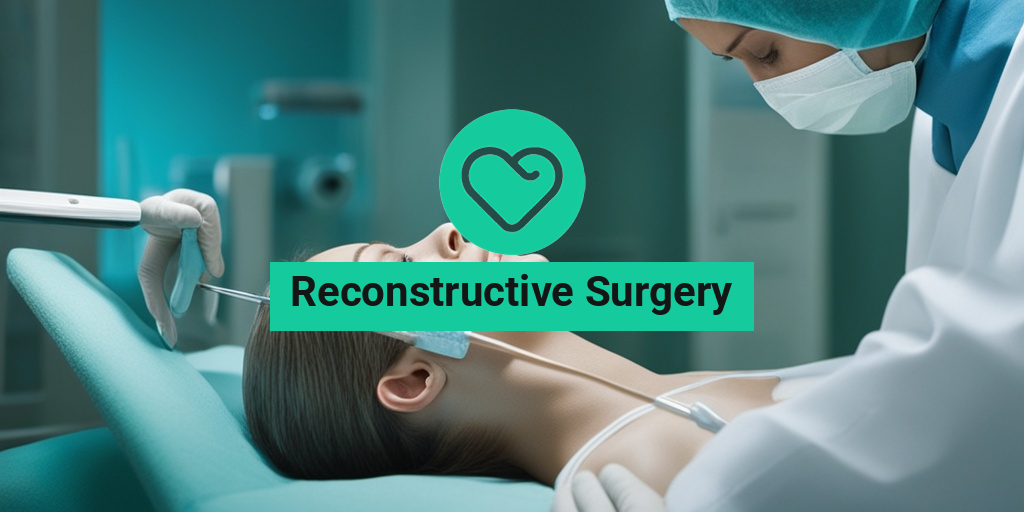What is Reconstructive Surgery?
Reconstructive surgery is a type of surgical procedure that aims to restore the form and function of a damaged or deformed body part. It’s a vital medical intervention that can greatly improve the quality of life for individuals who have suffered from injuries, birth defects, diseases, or other conditions that affect their physical appearance and functionality.
Reconstructive surgery is not the same as cosmetic surgery, although the two terms are often used interchangeably. While cosmetic surgery focuses on enhancing one’s appearance, reconstructive surgery is primarily concerned with repairing or reconstructing damaged tissues and organs to improve their function and overall health.
Reconstructive surgery can be performed on various parts of the body, including the face, hands, feet, and internal organs. The goal of reconstructive surgery is to restore normal function, alleviate pain, and improve the overall quality of life for the patient.
Types of Reconstructive Surgery
There are several types of reconstructive surgery, each designed to address specific health concerns and conditions. Here are some examples:
Microsurgery
Microsurgery involves the use of microscopes and specialized instruments to repair or reconstruct small blood vessels, nerves, and other delicate tissues. This type of surgery is often used to treat conditions such as peripheral nerve damage, lymphedema, and skin cancer.
Hand Surgery
Hand surgery, also known as hand reconstruction, is a type of reconstructive surgery that focuses on repairing or reconstructing damaged hands and fingers. This type of surgery can help restore hand function, alleviate pain, and improve overall hand mobility.
Breast Reconstruction
Breast reconstruction is a type of reconstructive surgery that involves rebuilding the breast tissue after a mastectomy or other breast surgery. This type of surgery can help restore the natural appearance and feel of the breast, improving self-confidence and overall quality of life.
Facial Reconstruction
Facial reconstruction involves the repair or reconstruction of damaged facial tissues, including skin, bone, and soft tissues. This type of surgery can help restore normal facial function, alleviate pain, and improve overall facial appearance.
Pediatric Reconstructive Surgery
Pediatric reconstructive surgery is a type of reconstructive surgery that focuses on treating children with birth defects, injuries, or other conditions that affect their physical appearance and functionality. This type of surgery can help improve the child’s quality of life, alleviate pain, and enhance their overall well-being.
These are just a few examples of the many types of reconstructive surgery available. If you’re considering reconstructive surgery, it’s essential to consult with a qualified healthcare professional to determine the best course of treatment for your specific needs.
Remember, reconstructive surgery is a complex medical procedure that requires careful consideration and planning. If you have any questions or concerns about reconstructive surgery, consider consulting with a qualified healthcare professional or visiting a reputable health website like Yesil Health AI for evidence-based health answers. 🏥💊

Benefits of Reconstructive Surgery
Reconstructive surgery is a type of surgery that aims to restore the normal function and appearance of a body part that has been damaged or deformed due to various reasons such as birth defects, injuries, diseases, or infections. The benefits of reconstructive surgery are numerous, and it can have a significant impact on a person’s quality of life.
Improved Physical Function
One of the most significant benefits of reconstructive surgery is the improvement in physical function. For example, reconstructive surgery can help restore the use of a limb, improve mobility, or enhance the ability to perform daily activities. This can greatly improve a person’s independence and overall well-being.
Enhanced Appearance
Reconstructive surgery can also improve the appearance of a body part, which can boost a person’s self-esteem and confidence. For instance, reconstructive surgery can help repair scars, birthmarks, or other deformities that can affect a person’s appearance.
Relief from Pain and Discomfort
Reconstructive surgery can also provide relief from pain and discomfort caused by a deformity or injury. For example, reconstructive surgery can help repair damaged tissues or nerves that can cause chronic pain.
Improved Mental Health
Reconstructive surgery can also have a positive impact on a person’s mental health. By improving physical function and appearance, reconstructive surgery can help reduce anxiety, depression, and other mental health issues.
Reconstructive Surgery for Birth Defects
Birth defects, also known as congenital anomalies, are abnormalities that occur during fetal development. These defects can affect various parts of the body, including the heart, brain, limbs, and organs. Reconstructive surgery can play a crucial role in correcting these defects and improving the quality of life for individuals born with them.
Common Birth Defects Treated with Reconstructive Surgery
Some common birth defects that can be treated with reconstructive surgery include:
- Cleft lip and palate
- Club foot
- Polydactyly (extra fingers or toes)
- Syndactyly (webbed fingers or toes)
- Craniosynostosis (abnormal skull shape)
Reconstructive Surgery Techniques
Reconstructive surgery techniques used to correct birth defects vary depending on the type and severity of the defect. Some common techniques include:
- Tissue expansion: This involves inserting a balloon-like device under the skin to stretch the tissue and create more skin to cover the defect.
- Tissue transfer: This involves transferring tissue from one part of the body to another to repair a defect.
- Bone grafting: This involves using bone from another part of the body to repair a defect in the bone.
- Prosthetics: This involves using artificial devices to replace missing or damaged body parts.
Reconstructive surgery can greatly improve the quality of life for individuals born with birth defects. By correcting physical deformities, reconstructive surgery can enhance physical function, appearance, and mental well-being. 💕

Reconstructive Surgery for Injuries
Accidents can happen to anyone, at any time. Whether it’s a car crash, a sports injury, or a fall, injuries can leave us with physical and emotional scars. In some cases, these injuries can be severe, requiring reconstructive surgery to restore function and appearance. In this section, we’ll explore the role of reconstructive surgery in treating injuries.
Injury Types that May Require Reconstructive Surgery
Reconstructive surgery can be used to treat a wide range of injuries, including:
- Facial injuries: Reconstructive surgery can help repair broken bones, lacerations, and other facial injuries, restoring a person’s natural appearance and function.
- Hand and finger injuries: Reconstructive surgery can help repair damaged tendons, nerves, and bones in the hand and fingers, restoring mobility and function.
- Burn injuries: Reconstructive surgery can help repair damaged skin and underlying tissues, reducing scarring and improving mobility.
- Orthopedic injuries: Reconstructive surgery can help repair damaged bones, joints, and muscles, restoring mobility and function.
The Benefits of Reconstructive Surgery for Injuries
Reconstructive surgery can have a significant impact on a person’s quality of life, providing numerous benefits, including:
- Improved function: Reconstructive surgery can help restore mobility and function, allowing individuals to return to their normal activities.
- Enhanced appearance: Reconstructive surgery can help improve the appearance of injured areas, boosting self-confidence and self-esteem.
- Reduced pain: Reconstructive surgery can help reduce chronic pain and discomfort, improving overall well-being.
- Increased independence: Reconstructive surgery can help individuals regain independence, reducing their reliance on others for daily tasks.
Reconstructive Surgery for Cancer Patients
Cancer treatment can be a long and challenging journey, often involving surgery, chemotherapy, and radiation therapy. In some cases, cancer treatment can result in physical changes, such as the removal of a breast or other body parts. Reconstructive surgery can play a vital role in helping cancer patients restore their physical appearance and confidence.
Types of Reconstructive Surgery for Cancer Patients
Reconstructive surgery can be used to treat a range of cancer-related conditions, including:
- Breast reconstruction: Reconstructive surgery can help restore the shape and appearance of the breast after a mastectomy or lumpectomy.
- Head and neck reconstruction: Reconstructive surgery can help repair damaged tissues and structures in the head and neck area, restoring appearance and function.
- Abdominal reconstruction: Reconstructive surgery can help repair damaged tissues and structures in the abdominal area, restoring appearance and function.
The Benefits of Reconstructive Surgery for Cancer Patients
Reconstructive surgery can have a profound impact on a cancer patient’s quality of life, providing numerous benefits, including:
- Improved body image: Reconstructive surgery can help restore a person’s natural appearance, boosting self-confidence and self-esteem.
- Enhanced emotional well-being: Reconstructive surgery can help reduce feelings of anxiety and depression, improving overall emotional well-being.
- Increased confidence: Reconstructive surgery can help individuals feel more confident and comfortable in their own skin, improving their overall quality of life.
Reconstructive surgery can be a powerful tool in helping individuals recover from injuries and cancer treatment. By restoring physical appearance and function, reconstructive surgery can improve overall quality of life, boosting confidence, self-esteem, and emotional well-being. 💕

Reconstructive Surgery for Scar Revision
Scars can be a constant reminder of a past injury, surgery, or trauma. While they may not be painful, they can affect one’s self-esteem and confidence. Fortunately, reconstructive surgery offers a solution for scar revision, helping to improve the appearance of scars and restore a more natural look to the skin.
What is Scar Revision Surgery?
Scar revision surgery, also known as scar reconstruction, is a type of reconstructive surgery that aims to improve the appearance of scars. The goal of the surgery is to minimize the visibility of the scar, making it less noticeable and blending it with the surrounding skin.
Types of Scars that Can Be Revised
Reconstructive surgery can be used to revise various types of scars, including:
- Hypertrophic scars: These are raised, red, and thick scars that can be itchy and painful.
- Keloid scars: These are large, raised scars that can be darker than the surrounding skin.
- Contracture scars: These are scars that restrict movement due to skin contraction.
- Acne scars: These are scars caused by acne, which can be deep and pitted.
The Scar Revision Surgery Process
The scar revision surgery process typically involves the following steps:
- Consultation: The surgeon will examine the scar and discuss the best course of treatment with the patient.
- Surgery: The surgeon will use various techniques, such as excision, skin grafting, or Z-plasty, to revise the scar.
- Recovery: The patient will need to follow post-operative instructions to ensure proper healing and minimize scarring.
💉 Remember, scar revision surgery is a process that requires patience, and it may take several months to a year for the final results to be visible.
—
Reconstructive Surgery Risks and Complications
While reconstructive surgery can be life-changing, it’s essential to be aware of the potential risks and complications involved. As with any surgical procedure, there are risks associated with reconstructive surgery, and it’s crucial to discuss these with your surgeon before making a decision.
Common Risks and Complications
Some common risks and complications associated with reconstructive surgery include:
- Bleeding and hematoma: Excessive bleeding during or after surgery can lead to hematoma, a collection of blood under the skin.
- Infection: Bacterial or fungal infections can occur after surgery, which can be treated with antibiotics or antifungal medication.
- Scarring: While reconstructive surgery aims to improve the appearance of scars, it’s possible to develop new scars or worsen existing ones.
- Nerve damage: Damage to nerves during surgery can cause numbness, tingling, or loss of sensation in the affected area.
- Reaction to anesthesia: Adverse reactions to anesthesia can occur, which can be life-threatening in rare cases.
Minimizing Risks and Complications
To minimize the risks and complications associated with reconstructive surgery, it’s essential to:
- Choose a qualified surgeon: Select a board-certified surgeon with experience in reconstructive surgery.
- Follow pre-operative instructions: Adhere to your surgeon’s instructions to prepare for surgery and minimize risks.
- Follow post-operative instructions: Carefully follow your surgeon’s instructions to ensure proper healing and minimize complications.
💊 Remember, it’s crucial to weigh the potential benefits of reconstructive surgery against the potential risks and complications. Discuss your concerns with your surgeon to make an informed decision.

Frequently Asked Questions about Reconstructive Surgery
What is Reconstructive Surgery?
Reconstructive surgery is a type of surgery that aims to restore the normal function and appearance of a damaged or deformed body part. It can be used to repair injuries, correct birth defects, or restore body parts affected by disease or trauma.
What are the Benefits of Reconstructive Surgery?
Reconstructive surgery can improve the quality of life for individuals with physical deformities or injuries. It can help restore confidence, improve mobility, and enhance overall well-being. Additionally, reconstructive surgery can also improve physical function, alleviate pain, and improve overall health.
What are the Types of Reconstructive Surgery?
There are various types of reconstructive surgery, including:
- Breast reconstruction after mastectomy
- Facial reconstruction after injury or trauma
- Hand reconstruction after injury or birth defect
- Microsurgery to reattach severed limbs
- Reconstructive surgery after childbirth or vulvectomy
How Long Does Reconstructive Surgery Take?
The length of reconstructive surgery can vary depending on the complexity of the procedure and the individual’s overall health. Some procedures may take a few hours, while others may require several days or even weeks in the hospital.
Is Reconstructive Surgery Painful?
Reconstructive surgery can be painful, but most surgeons use anesthesia to minimize discomfort during the procedure. After the surgery, pain medication can be prescribed to manage any discomfort or pain.
How Much Does Reconstructive Surgery Cost?
The cost of reconstructive surgery varies depending on the type of procedure, the surgeon’s fees, and the location of the surgery. In some cases, insurance may cover part or all of the cost of reconstructive surgery.
What is the Recovery Time for Reconstructive Surgery?
The recovery time for reconstructive surgery can vary depending on the individual’s overall health and the complexity of the procedure. In general, it can take several weeks to several months to fully recover from reconstructive surgery.
Are There Any Risks or Complications Associated with Reconstructive Surgery?
As with any surgery, there are risks and complications associated with reconstructive surgery. These can include infection, bleeding, scarring, and reaction to anesthesia. It’s essential to discuss the potential risks and complications with your surgeon before undergoing reconstructive surgery.
How Do I Find a Qualified Reconstructive Surgeon?
To find a qualified reconstructive surgeon, ask for referrals from your primary care physician or other healthcare professionals. You can also check with professional organizations, such as the American Society of Plastic Surgeons, to find a board-certified reconstructive surgeon in your area.
What is the Success Rate of Reconstructive Surgery?
The success rate of reconstructive surgery varies depending on the type of procedure and the individual’s overall health. In general, reconstructive surgery can be highly effective in restoring function and appearance to damaged or deformed body parts.
Can Reconstructive Surgery Be Combined with Other Procedures?
Yes, reconstructive surgery can be combined with other procedures, such as cosmetic surgery or other medical procedures, to achieve optimal results.
Is Reconstructive Surgery Covered by Insurance?
In some cases, reconstructive surgery may be covered by insurance, especially if it’s deemed medically necessary. It’s essential to check with your insurance provider to determine the extent of coverage.
What is the Follow-Up Care Like After Reconstructive Surgery?
Follow-up care after reconstructive surgery typically involves regular check-ups with your surgeon to monitor the healing process and address any concerns or complications that may arise.
Can I Get Reconstructive Surgery Abroad?
Yes, it’s possible to get reconstructive surgery abroad, but it’s essential to do your research and ensure that the surgeon and facility meet high standards of care and safety.
How Long Do the Results of Reconstructive Surgery Last?
The results of reconstructive surgery can last for many years, but the exact duration depends on the type of procedure, the individual’s overall health, and the quality of the surgery.
Can Reconstructive Surgery Be Reversed?
In some cases, reconstructive surgery can be reversed, but it’s essential to discuss the potential risks and complications with your surgeon before undergoing the procedure.
What are the Alternatives to Reconstructive Surgery?
Alternatives to reconstructive surgery may include physical therapy, prosthetics, or other non-surgical treatments, depending on the individual’s condition and needs.
Can I Get Reconstructive Surgery if I Have a Pre-Existing Condition?
In some cases, individuals with pre-existing conditions may be eligible for reconstructive surgery, but it’s essential to discuss the potential risks and complications with your surgeon before undergoing the procedure.
What is the Age Limit for Reconstructive Surgery?
There is no specific age limit for reconstructive surgery, but the individual’s overall health and medical condition will be taken into consideration when determining eligibility for the procedure.
Can I Get Reconstructive Surgery if I’m Pregnant or Breastfeeding?
In general, reconstructive surgery is not recommended during pregnancy or breastfeeding, as it may pose risks to the mother and baby. However, it’s essential to discuss the potential risks and complications with your surgeon before undergoing the procedure.
What are the Emotional and Psychological Benefits of Reconstructive Surgery?
Reconstructive surgery can have a significant impact on an individual’s emotional and psychological well-being, improving self-esteem, confidence, and overall quality of life.
Can Reconstructive Surgery Improve My Body Image?
Yes, reconstructive surgery can improve body image by restoring the normal appearance and function of damaged or deformed body parts, leading to increased confidence and self-esteem.
How Do I Prepare for Reconstructive Surgery?
To prepare for reconstructive surgery, it’s essential to follow your surgeon’s instructions, stop smoking, avoid certain medications, and make arrangements for post-operative care and support.
What are the Common Misconceptions About Reconstructive Surgery?
Common misconceptions about reconstructive surgery include the idea that it’s only for cosmetic purposes, that it’s not covered by insurance, or that it’s only for individuals with severe injuries or deformities.
What are the Latest Advancements in Reconstructive Surgery?
The latest advancements in reconstructive surgery include the use of 3D printing, robotic surgery, and advanced microsurgery techniques, which have improved the accuracy and effectiveness of reconstructive procedures.
Can Reconstructive Surgery Be Used to Treat Chronic Conditions?
Yes, reconstructive surgery can be used to treat chronic conditions, such as chronic pain, by repairing or replacing damaged tissues and restoring normal function.
How Does Reconstructive Surgery Differ from Cosmetic Surgery?
Reconstructive surgery is focused on restoring function and appearance to damaged or deformed body parts, while cosmetic surgery is focused on enhancing appearance for aesthetic purposes.
What is the Role of Reconstructive Surgery in Trauma Care?
Reconstructive surgery plays a critical role in trauma care, helping to restore function and appearance to individuals with severe injuries or deformities.
Can Reconstructive Surgery Be Used to Treat Birth Defects?
Yes, reconstructive surgery can be used to treat birth defects, such as cleft palate or club foot, by repairing or reconstructing damaged tissues and restoring normal function.
What is the Future of Reconstructive Surgery?
The future of reconstructive surgery holds promise with advancements in technology, such as 3D printing and robotic surgery, which will continue to improve the accuracy and effectiveness of reconstructive procedures.
Sources
- https://www.mayoclinic.org/departments-centers/plastic-surgery/sections/overview/ovc-20473067
- https://www.mayoclinichealthsystem.org/services-and-treatments/plastic-and-reconstructive-surgery
- https://www.mayoclinic.org/departments-centers/facial-plastic-and-reconstructive-surgery/overview/ovc-20425011




